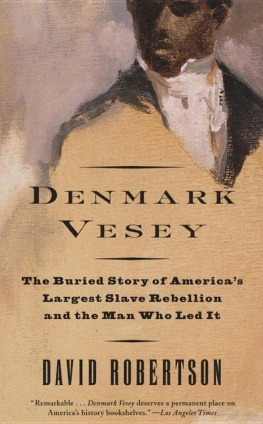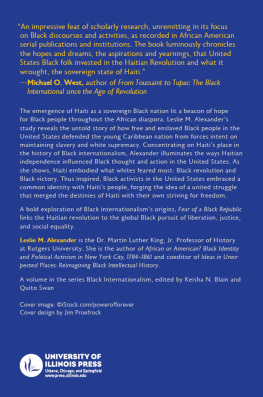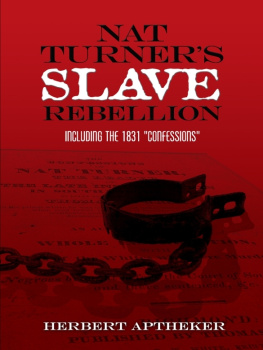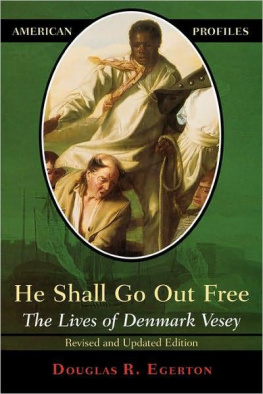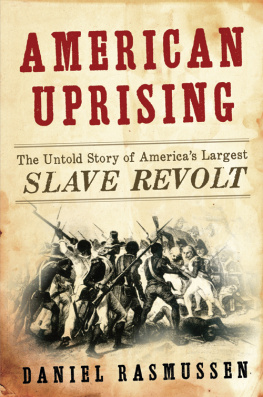The Reality of Denmark Vesey
N O ONE THOUGHT to describe his face. For seven days during his trial and sentencing, he was kept under constant guard at the Work House, a frame building for the punishment of slaves, located near the marshes that then marked the western limit of the city of Charleston, South Carolina. No black person without a special authorization was allowed within two blocks of the building, while throughout that third week of June 1822, freemen and slaves under arrest came and gave testimony against him inside a small room on the upper story of the prison. Later that autumn, after his hanging, two of his judges published an official record of the proceedings. It totals printed pages of evidence and testimony, complete with an Introduction and Narrative. But at no point in this text did any of his judges think it necessary to describe his features. Throughout his trial and sentencing, he is officially depicted simply as a black man, and as a freeman.
The enigma of his face returned to confront the city of Charleston 154 years after his execution. In 1976, the city commissioned his portrait to be painted and placed in honor at the new municipal auditorium. The artist selected was thus presented with the problem of portraying a man of whom there was no known likeness. But this was by no means the only difficulty. If black leaders in Charleston had searched for a thousand years, a white columnist for the Charleston News and Courierwrote when the art project became known, they could not have found a local black whose portrait would have been more offensive to many white people. A letter to the same newspaper, presumably from a white correspondent, proposed that if this man deserved such an honor, we should also hang portraits of Hitler, Attila the Hun [and] Herod the murderer of babies. Responding to this criticism, the bishop of the African Methodist Episcopal Church at Charleston replied, We know what he intended to do to them, and we know what they did to him. The man to be pictured, the A.M.E. bishop said, was a liberator whom God sent to set the people free from oppression. The portrait eventually was finished, and in a public ceremony it was placed in Charlestons Gaillard Auditorium. The artist solved his problem by portraying his subject facing away from the pictures frame and addressing a group of his black followers. Well over 150 years after his death, Denmark Vesey still turns his back on the twentieth-century observer.
Denmark Vesey in 1822 organized the most elaborate and well-planned slave insurrection in the history of the United States. Had it succeeded, it also would have been the most violent. Nine years before Nat Turners slave revolt in Virginias Tidewater district, and thirty-seven years before John Browns raid at Harpers Ferry, Vesey planned to seize the United States arsenal and ships at harbor in Charleston, then the fifth-largest city in the nation. In preparation for this attack, he recruited perhaps nine thousand slaves in his cause. He preached to them the doctrine of negritude, the shared spiritual identity of all people of color, whether in Africa, the Americas, or the West Indies. Three months before the date of the planned uprising, he corresponded with the president of the new black Republic of Haiti, in hopes of obtaining that nations military aid in his rebellion. On the night of the uprising, trusted house servants who were among his closest coconspirators were to assassinate the governor of South Carolina and other important state officials as they slept in their Charleston homes. Vesey had prepared six infantry and cavalry companies of armed slaves to roam through the streets of Charleston following these deaths, and murder the entire white population, including children. The city itself was to be burned to its foundations with explosives and incendiaries he had obtained for that purpose. The sole whites to be spared would be the captains of ships seized after the revolt to carry him and his followers to Haiti or Africa.
He failed, and in the summer of 1822, Vesey and seventy-seven of his followers were hanged or imprisoned. But when the details of the Vesey plot and the fact of its near-success became known outside of Charleston, his planned actions had consequences throughout nineteenth-century American history. The then U.S. president, James Monroe, withheld diplomatic recognition of the Republic of Haiti after he learned of the plot; the United States would not grant recognition to this republic, founded on the same revolutionary principles as the United States, until 1863. A former U.S. president, Thomas Jefferson, saw in the events at Charleston a melancholy confirmation that black slavery inevitably would sunder the nation which he, in his generation, had worked to make whole; and the secretary of war in 1822, John C. Calhoun, quietly began transferring sympathetic U.S. officers and troops southward to support the slaveholding states in the coming crisis. Forty-three years later, on Good Friday, April 14, 1865, after a civil war that had claimed more than 800,000 military and civilian lives, the flag of the United States was raised for the first time since the beginning of the war over the rubble that was now Fort Sumter in Charleston Harbor. A crowd of more than four thousand people, most of them ex-slaves from the surrounding plantations, began to sing The Star-Spangled Banner. Among them was Denmark Veseys son.

